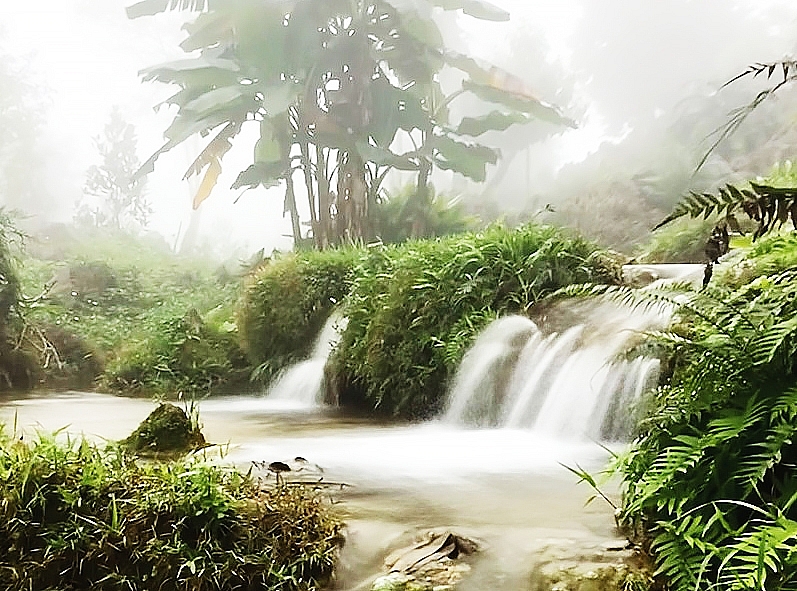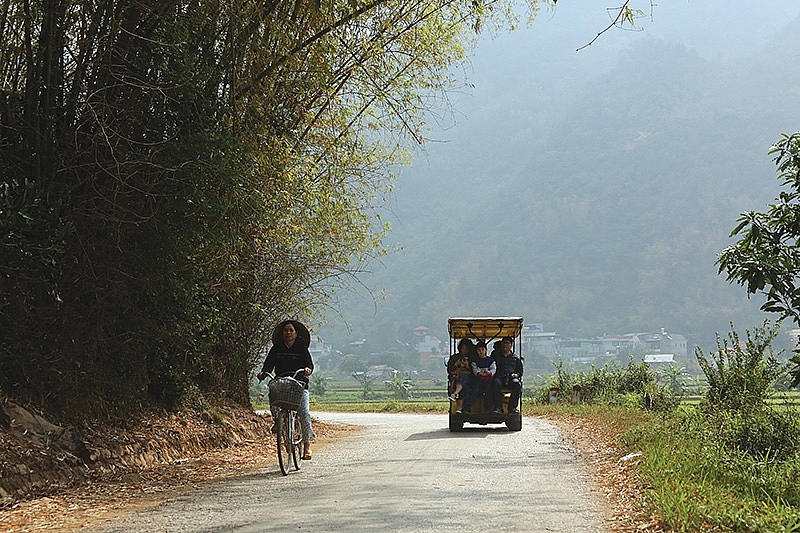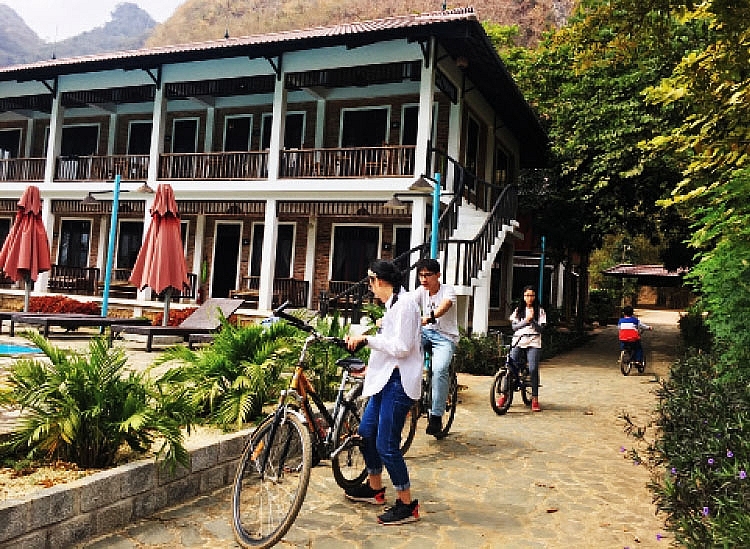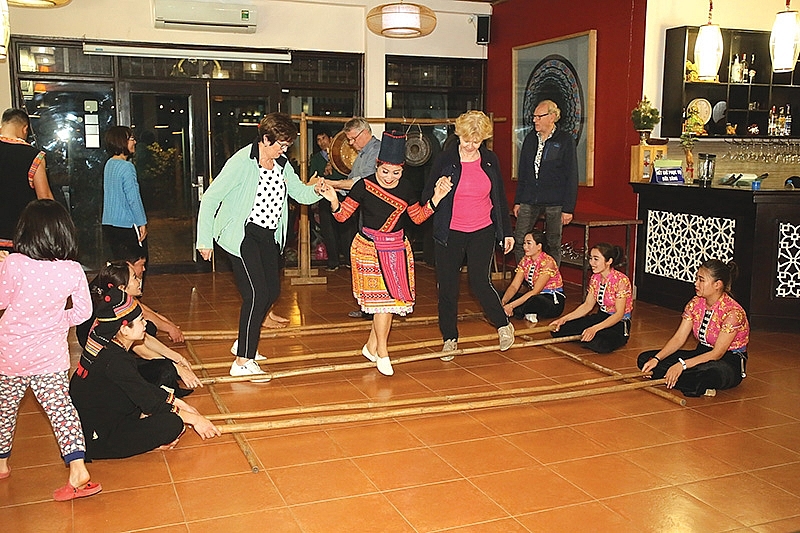Up and Down in the green Mai Chau getaway
 |
| Up and Down in the green Mai Chau getaway |
After driving up the zigzag mountain passes and slopes, we get to spectacular views of the valley. Viewed from the top of Mai Chau pass, the valley looks like a green oasis with brown and red tiled roofs, covered with lush palm trees and dense bamboo hedges.
At first sight, Mai Chau town is like any other modern town around the country, not a typical Thai-style village as we expected.
However, passing down the 2km-long main road, we touch a verdant rice paddy field with brown Thai-style stilt-houses and bungalows lying along the hillslopes, surrounded by bamboo hedges.
While farmers are guiding their cattle through the village’s streets, the sound of their bells is chiming through the quiet air, dragonflies are dancing amongst the rice paddies, and bright green covers the fields and hills, with children racing on bicycles and screeching with laughter.
 |
Over 10 years ago, homestays have been developed in the green valley as a hotspot for both local and foreign tourists to experience new and relatively unheard tourism model in Vietnam. These days, the concept is becoming increasingly popular, creating a special attraction within Vietnam’s tourism industry.
However, despite the new model, Mai Chau’s homestay villages still honour the poetic beauty of the valley with its honest and friendly people. It is still an ideal choice for those who value timeless simplicity and traditional touches in one of the most incredible parts of northern Vietnam.
You can discover the fascinating lives of the Mai Chau hill tribes by day and bask in ultimate relaxation by night.
 |
Homestays can be likened to visiting the home of a friend or relative, as guests will be introduced to the best destinations, eat the most delicious food, and learn more about the local lifestyle as well as the differences in the way of thinking of each region. However, facilities are relatively limited compared with a hotel or resort.
This time, my family and I chose the resort Mai Chau Ecolodge on Pom Pu Hill, far from the bustling Mai Chau town and the homestay villages. The unique lodge offers spectacular views of the valley from nearly any angle.
Viewed from a distance, the ecolodge looks like an ancient Thai village, complete with quaint stilt houses and palm trees. The main stilt house was based on the idea of a Lang’s House - a mandarin of the Thai people.
Its operation is based on the principles of sustainable tourism, inspired by the current responsible tourism trend which provides benefits for visitors and local citizens whilst minimising the negative environmental impact.
 |
Accordingly, solar energy is the primary source of power. All of the lodge’s outdoor lighting systems use solar energy, and are charging during daylight hours ready for use at night. The room lights primarily use solar energy too and automatically switch to using the national electricity grid if necessary. The hot water in the rooms is integrated into two systems, with preference given to solar energy.
Water is derived from limestone deposits in a natural cave, roughly 1km from the lodge. Moreover, 50 per cent of the energy used for cooking is biomass.
Rice husks and sawdust are collected, along with leaves and garbage which are all placed into a biomass furnace. The pale smoke containing carbon monoxide is forced into gas stoves and burned as a gas fossil. The flame’s intensity can be adjusted accordingly.
This technology has been used by Vietnamese farmers for many years. It is a valuable lesson for children to learn from the past and possibly apply to modern life with a lifestyle more concerned about nature.
When the night falls, after a delicious dinner with traditional food of Thai people, including bamboo-tube rice and charcoal grilled river fish, we enjoy a special performance with some colourful bamboo dancing.
If you have some free time, it is a great idea to spend around two hours driving from the valley to Pu Luong Nature Reserve. The reserve is unrivaled with its idyllic, serene beauty. Spanning across two districts of Thanh Hoa province, the reserve covers two parallel mountain ridges with a large valley between the mountains that is home to several traditional farming villages and vast sections of rice paddies.
As the cultivated land is not part of the nature reserve, several homestays and the Pu Luong Retreat can be found here, giving visitors some relaxing options for a well-deserved rest.
You can also stick close to town and learn about the local handicraft industry or try your hand at a cooking class. However, if your time is limited, do not miss the mountain biking or trekking to remote hill tribe villages of the Mong, Thai, and Dao people around the valley.
Alternatively, you can embark on a kayaking tour in the Hoa Binh reservoir which is just a 30-minute drive from the valley.
Arguably, the best way to understand a land is to experience its culture and customs through spending time with the local people and exploring the natural beauties in the most natural ways. In this regard, Mai Chau offers a fascinating experience that I can highly recommend.What the stars mean:
★ Poor ★ ★ Promising ★★★ Good ★★★★ Very good ★★★★★ Exceptional
Themes: Safe and Sound Vietnam
Related Contents
Latest News
More News
- The destinations powering Vietnam’s festive season travel demand (December 04, 2025 | 18:33)
- Vietnam named among the world’s most exciting winter destinations (December 04, 2025 | 15:10)
- Phu Tho emerges as northern Vietnam’s new tourism hub (December 01, 2025 | 17:00)
- Vietjet completes Airbus A320/A321 updates ahead of deadline (December 01, 2025 | 09:49)
- Vietjet resumes Con Dao flights from early December (November 28, 2025 | 15:24)
- Free tickets, Lunar New Year promotions on offer at Vietjet Mega Livestream (November 26, 2025 | 15:32)
- Scandinavian Airlines and Vietnam Airlines broaden agreement with new routes (November 25, 2025 | 17:04)
- Halong Cruise Port welcomes over 3,100 international visitors (November 12, 2025 | 18:06)
- Vietnam.travel climbs to second place in Southeast Asia website rankings (November 12, 2025 | 18:01)
- Cat Ba named among Southeast Asia’s top island adventures (November 11, 2025 | 18:09)

 Tag:
Tag:






















 Mobile Version
Mobile Version